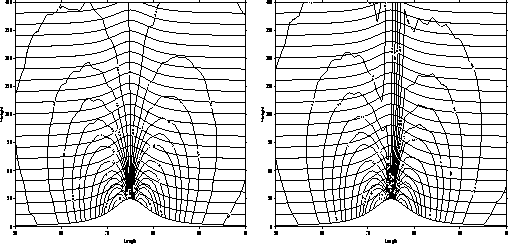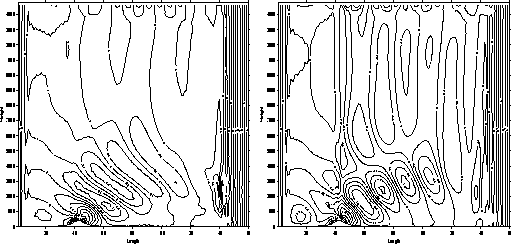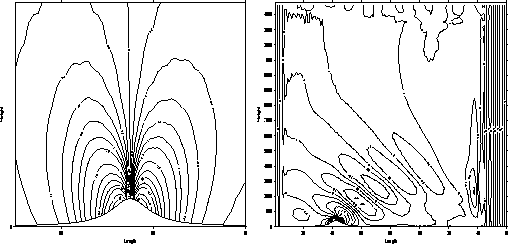
8. Chistopher SMITH :"Stability analysis and precision aspects of the boundary condition formulation in the non-hydrostatic dynamics and exploration of the alternatives for discrete formulation of the vertical acceleration equation both in Eulerian and semi-Lagrangian time marching schemes"
1. Introduction
This work has continued in the context of the two-dimensional vertical slice model. Two idealised test cases have been used to investigate a significant difference in behaviour between the Eulerian and semi-Lagrangian schemes. Both tests involve flow over an isolated mountain, one being flow in a nonlinear, non-hydrostatic regime; the other being in a potential flow regime, also non-hydrostatic. In the first case there is strong downstream propagation of gravity waves, which are generated by deformation of the flow as it passes over the orography. In the potential flow case the response to the orography is evanescent, rather than being a propagating wave. For both tests good results may be obtained using the Eulerian scheme. However, the semi-Lagrangian scheme introduces a severe defect, largely contained in the region directly above the mountain.
The defect in the semi-Lagrangian scheme has been traced to the lack of an effective free-slip lower boundary condition. Such a boundary condition has proved to be elusive, due to difficulties introduced by the use of vertical divergence as a prognostic variable. These difficulties are largely removed by using vertical wind as a prognostic variable, while still retaining vertical divergence within the linear model of the semi-implicit scheme.
This remedy brings the results obtained using the semi-Lagrangian and Eulerian schemes into close agreement. The primary reason for choosing to use a semi-Lagrangian scheme is to be able to run the model with time-steps longer than those allowed by the Eulerian scheme. The modified semi-Lagrangian scheme, described above, does allow such an increase in time-step. Unfortunately this is only so in the nonlinear non-hydrostatic test case if somewhat large temporal decentering is also used.
2. Standard Results
All of the following results were obtained using version 12 of ALADIN.
Potential flow test
For this test the atmosphere is isentropic, with potential temperature 280 K and reference pressure 101325 Pa. At the inflow boundary the flow is horizontal, the wind speed being 15 m/s at all levels. The flow encounters a mountain with Witch of Agnesi profile (the classic bell-shape used in most studies of this kind). The peak mountain height is 50 m and the half-width parameter is 100 m. Figure 1 shows the vertical wind field after model integrations using the Eulerian and three time-level semi-Lagrangian schemes. The horizontal mesh length is 20 m and the vertical mesh length is approximately also 20 m. There are 39 grid levels. The Eulerian scheme produces a result which is in excellent agreement with an analytical linearized solution. However, the semi-Lagrangian scheme has completely spurious behaviour located over the mountain and extending throughout the depth of the modelled atmosphere.
Nonlinear non-hydrostatic flow test
The inflow boundary condition for this test has a vertical temperature profile for which the Brunt-Väisälä frequency is constant, with value 0.01 Hz. The temperature at zero height is 285 K and the horizontal inflow wind speed is 4 m/s. Again the mountain has the Witch of Agnesi profile but this time with peak height and half-width both 400 m. Figure 2 shows the vertical wind field obtained using, on the left, the Eulerian scheme and, on the right, the three time-level semi-Lagrangian scheme. The mesh length is 80 m in the horizontal and approximately 365 m in the vertical, with 41 levels. Once more we see that the Eulerian scheme provides a good solution, while the semi-Lagrangian scheme suffers spurious behaviour linked to the orography.

Figure 1 : Steady state solutions of potential flow problem using ALADIN. Left: Eulerian scheme. Right: three time-level semi-Lagrangian scheme. Only part of domain is shown, to highlight the solution close to the mountain. Horizontal lines are geopotential height of grid levels. Time-step 0.1s, 800 steps. The flow is from left to right.

Figure 2 : Steady state solutions for nonlinear non-hydrostatic test, obtained using Eulerian scheme (left) and three time-level semi-Lagrangian scheme (right). Entire domain is shown. Integration in each case is for 1000 steps with time-step 2s.
3. Results using vertical wind as prognostic variable
In this modified scheme vertical wind is used as the prognostic variable. This allows the free-slip lower boundary condition to be imposed simply by over-writing the values of vertical wind on the lower boundary. This is done at the end of the gridpoint calculations, before the semi-implicit solver is called. If V+(0) and w+(0) are the horizontal and vertical wind approximations formed at the end of the gridpoint calculations, then we simply set:
![]()
where index L* indicates the lower boundary, index L is the first full model-level above the boundary and Φs is the geopotential height of the orography. The results obtained, using the semi-Lagrangian scheme modified in this way, are shown in Figure 3. It should be noted that further improvement, especially in the potential flow test, is obtained by using so-called linear truncation in the spectral representation. Using additional Fourier modes removes the ``cauliflower'' effect seen in some of the low wind-speed contours.

Figure 3 : Results for potential flow test (left) and nonlinear non-hydrostatic flow test (right). These were obtained using the three time-level semi-Lagrangian scheme, with vertical wind as prognostic variable.
4. Discussion
For inviscid flow the free-slip lower boundary condition is a necessary condition connecting the horizontal and vertical winds. Ideally this constraint should be satisfied exactly at all time-levels. However, this is not always the case in weather forecasting models. In practice such a deficiency may not be too detrimental to the model, where physical parameterizations play an important role near the surface. In view of this we may describe the proposed implementation of the free-slip condition as being pragmatic: it is a solution which offers some potential improvement in forecast skill, while still falling short of being the most desirable mathematically correct solution. Instead of the free-slip constraint being built in to the structure of the model, the proposed solution is to reinforce the free-slip condition at every time-step by simple over-writing of data.
In the case where vertical divergence is the prognostic variable, not only do we not have the free-slip constraint built in to the model, it is also not clear how a pragmatic solution may be imposed. Since vertical divergence involves differences in vertical wind across model layers, it would perhaps be necessary to alter data at all model levels, not just near the lower boundary, in order to impose the free-slip condition. The way in which this might be done appears to be entirely ad hoc.
Finally, it should be noted that the results obtained using the Eulerian scheme, shown above, were all obtained using integrations at very low Courant numbers. At low Courant numbers the Eulerian scheme inherits a good approximation to the free-slip condition from the data at previous time-levels. This is not so in the semi-Lagrangian case, where interpolation of data to laterally displaced points is involved.
5. Future work
Future work will investigate the impact of the choice of non-hydrostatic pressure variable on the modified semi-Lagrangian scheme. Also these developments will be carried over into the predictor-corrector framework, which is also currently under development. The goal for bringing these two development lines together is to obtain a robust and stable semi-Lagrangian scheme, with minimal orography-related defects.
9. Cornel SOCI : "Sensitivity study at high resolution using a limited-area model"
A paper entitled : "High resolution sensitivity studies using the adjoint of the ALADIN mesoscale numerical weather prediction model" was submitted to Idojaras. Results were also presented at the joint EWGLAM / SRNWP meeting (Cracow, 8-12 October 2001). Now it is time to write the thesis manuscript. More details in the next Newsletter.
10. Klaus STADLBACHER : "Systematic qualitative evaluation of high-resolution non-hydrostatic model"
Nothing new since the last Newsletter (work at ZAMG).
| The previous ALATNET PhD and Post-Doc Studies |  |
Home | The next ALATNET PhD and Post-Doc Studies |